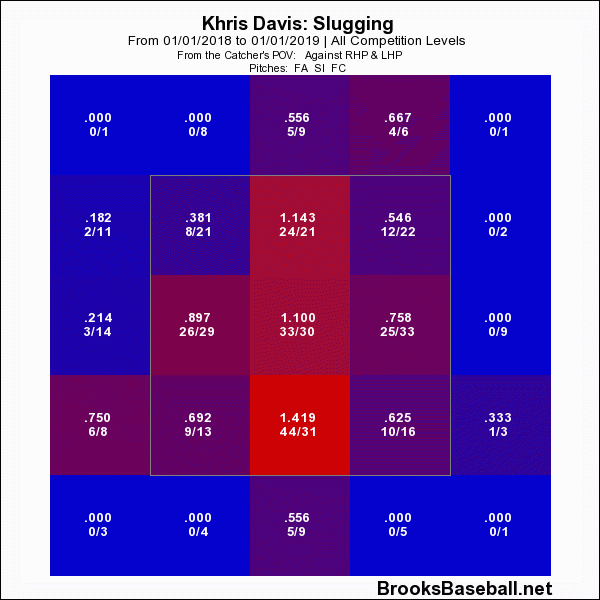
The lull between Christmas and New Year’s Day is the perfect time of the year to be reflective.
In planning out a video looking back at the Oakland A’s 2019 season, coming to the YouTube channel soon, I started looking into Khris Davis’s struggles at the plate. The more in-depth part of this felt better suited to a blog post, so here it is.
When considering KD’s power outage, it’s hard to look past the collision he had on 5 May when playing left field at PNC Park. It was a Sunday day-game so I was watching live in the British evening and what initially looked fairly innocuous ended up being an injury that lingered until 1 June.
In 43 games across March, April and May Davis hit 12 home runs; in the 90 games from June 1 on he hit 11. That doesn’t tell the whole story, though, as even in the early part of the season KD was hitting home runs but not much else. It was said throughout the second half that he was healthy, a point picked up on in Shayna Rubin’s column on The Mercury News in early September, so the hunch that he was never quite right after that collision can’t be relied on to explain the struggles away.
Looking for some potential answers, I went diving into the data, firstly heading to FanGraphs.

If we look at the final section first, there’s very little difference between the two seasons in respect of soft, medium and hard contact percentage. He traded approximately 5% of centre hits for pull-side hits, which may be a sign of him trying to ‘power-up’ whilst mired in a near season-long slump. The interesting bit is in the first section, where we see that his fly-ball percentage dropped off by over 11%. Put simply, he wasn’t putting the ball in the air as often as he had in the past.
When I think of KD in his pomp, I think of a slugger who can wait on a breaking-ball mistake, but more often being someone who can whack fastballs a long way. With that in mind, I turned to BrooksBaseball and looked at what damage was, or more precisely wasn’t, being done to variations on fastballs (four-seams, cutters, sinkers etc).
Here’s the zone chart showing slugging percentage against hard-pitches in 2018, showing it from the catcher’s perspective (i.e. KD, as a right-handed hitter, would be standing on the left of the zone).

The main thing to note is his slugging percentage in the middle vertical column and more generally in the middle and bottom-third of the zone horizontally. Now, compare it with the same chart for 2019:

Other than the pitch high and away that he slugged 1.182 on, it’s a starkly depressing scene. If you want to sum up KD’s 2019 season in one go, grimace at the .208 slugging percentage on hard pitches middle-middle.
What should be middle-for-diddle for a hitter turned into middle-for-diddly-squat.
These two charts do come with the caveat that we’re looking at small sample sizes in each of those squares so they provide food for thought rather than a definitive conclusion. For example, Matt Olson only slugged .304 on hard pitches middle-middle in 2019, albeit doing a lot of damage on pitches in other spots around that area, so for both players some of that will be taking first-pitch or 3-0 strikes. The general trend still stands though: what KD slugged in 2018 he didn’t slug in 2019.
Even if Davis was physically healthy from June on, there could still have been an effect from the lay-off and also the initial attempts to play through the injury affecting his hitting mechanics. Getting out of a slump mid-season is a difficult thing to do, so that’s something Khris and the coaching staff will be looking at over the off-season and into Spring Training.
We were all so excited when the A’s managed to come to an agreement with Davis on a contract extension back in April. He’ll be our most expensive player in 2020 and 2021, earning $16.75m each year, and the A’s more than most teams need that size of a financial commitment to work out.
Hopefully he can get back to being the Krush we know and love in 2020.






